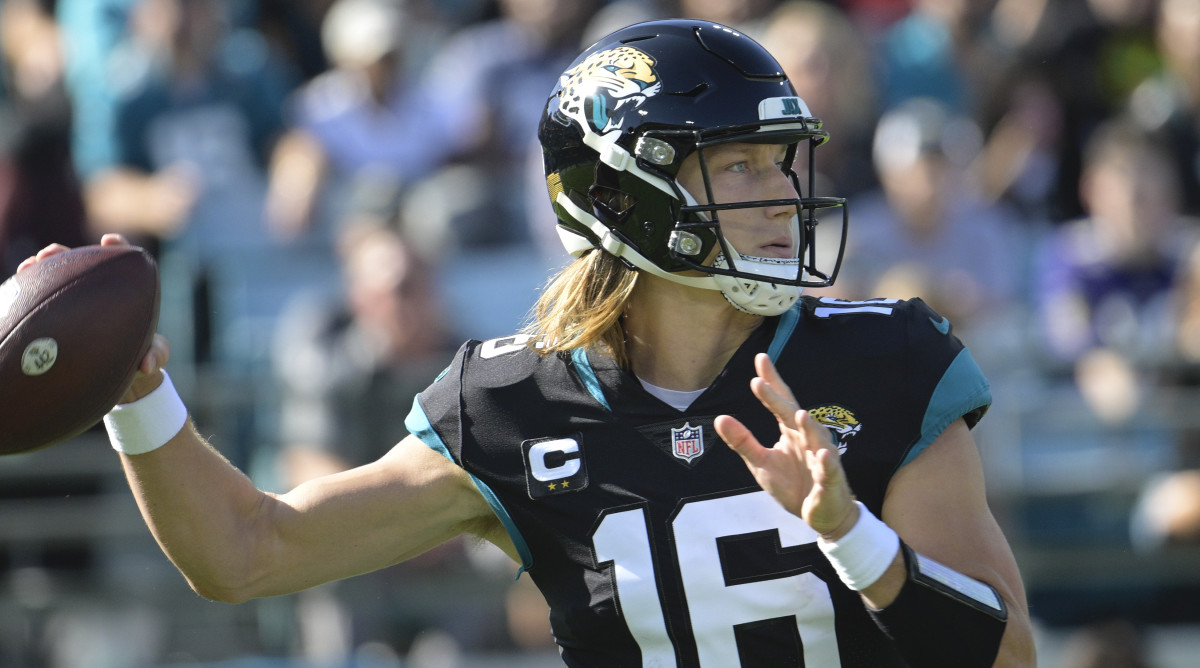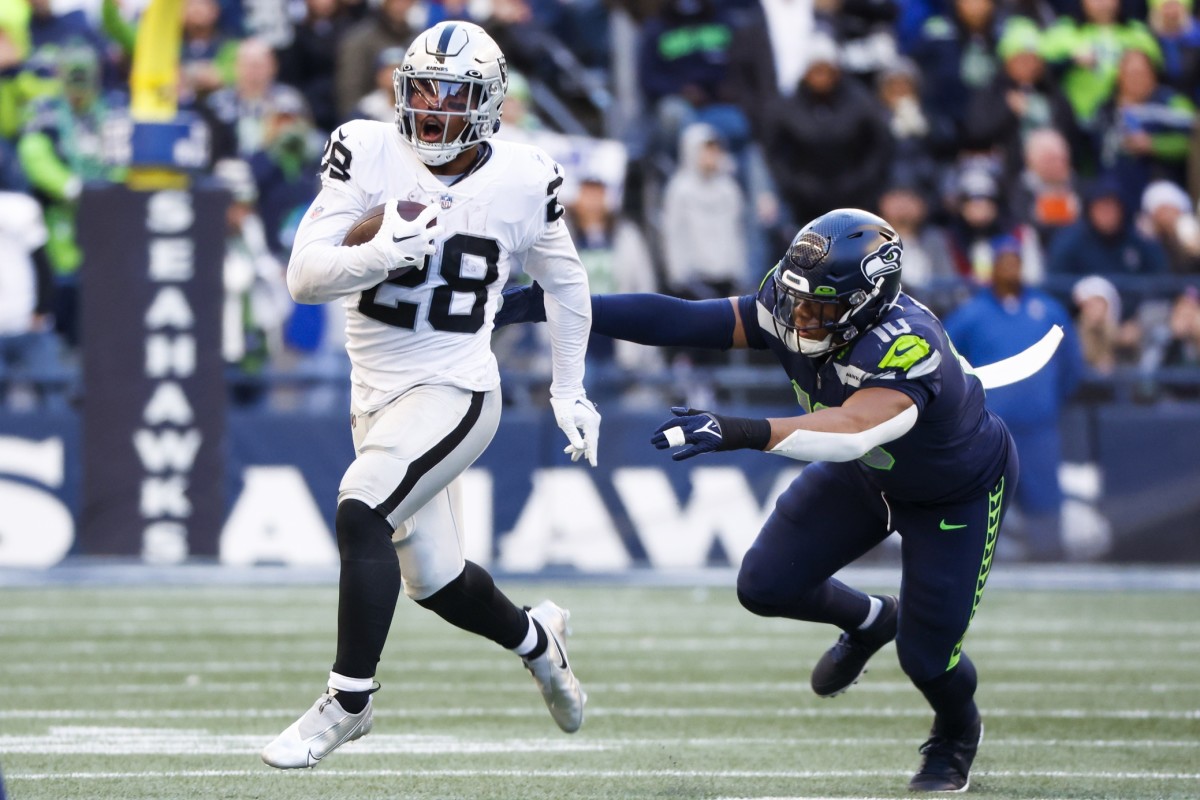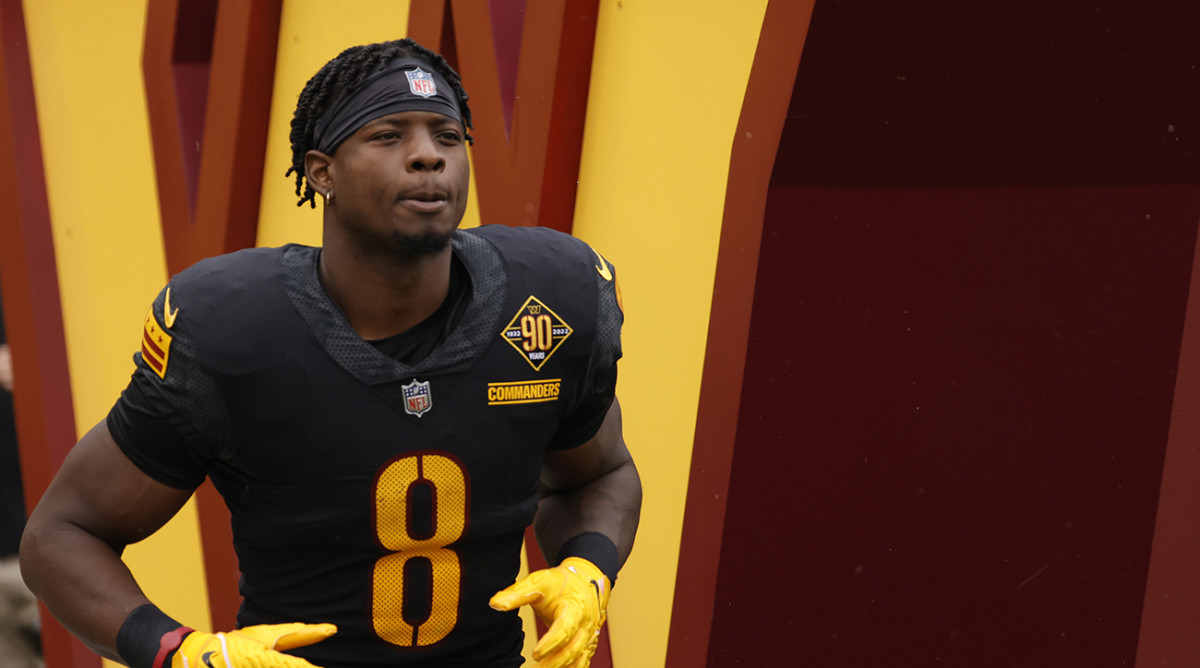The Reeducation of Trevor Lawrence Is Paying Dividends
We’re at the two-thirds pole (yeah, I know that’s not a real term), let’s go …
• Here’s a word that wasn’t often used to describe Trevor Lawrence over his three years at Clemson. Raw.
So it’s at least interesting that, as a rookie, NFL defensive coaches saw him that way. Bill Belichick actually said last January, near the end of the year, that Lawrence “looks like a real good prospect”, rather than just calling him a real good player. And that too is what Doug Pederson found when he arrived in North Florida a few weeks after that.
“He's had three head coaches in three years. Three coordinators, three position coaches, three different offenses,” Pederson told me Monday. “So yeah, raw, first-year, whatever it is, that's hard. That's hard on a young player, young quarterback in this league, where you're the face of the franchise and everything's riding on your shoulders, right? And we took him and we treated him almost like he didn't know anything. We were just pouring everything we know as a staff into him and getting him situational awareness, football awareness.
“He comes from a situation in college like a lot of these kids, I mean, they're on such great football teams with much better talent than their opponent and they don't really have to pay much attention to a lot of things. Where now, you come to this level, everything is magnified. Every little detail, every throw, every step, is magnified.”
In a nutshell, there’s an easy way to look at this. Clemson’s offense was pretty simple, and throwing to Tee Higgins, Hunter Renfrow, Justyn Ross, Cornell Powell and Travis Etienne over those years meant, more often than not, the play ran the way the play was supposed to run, and Lawrence didn’t have to go past his first read a ton. And being the athlete he is, when that did happen, he could pull the ripcord and run.
So it wasn’t that he couldn’t do a lot of NFL things, as much as he didn’t really have to that often. Which led to opposing coaches saying last year that Lawrence didn’t seem to see the field as fast as he needed to, or play as fast as they thought he would coming out.

Pederson and his staff have addressed that, and addressed it aggressively. And one way they’ve done it, Pederson explained to me, is to repeat play calls, so Lawrence gets to look deeper for answers within every call, and learns to see how different those answers might look depending on the opponent or even just the defensive call. The result has been that he’s processing specific calls faster, and playing faster in general.
That showed up big-time on Lawrence’s first touchdown Sunday, in which he stood tall in the pocket closing down around him and delivered a hole shot between a corner and a safety to JaMycal Hasty for a 28-yard score, on a call the Jaguars had repped specifically for the Ravens in practice.
“We knew specifically how Baltimore was going to align to that formation and that type of play, and he was able to take that—and that's just a little thing—but he was able to take that from practice and throw a great pass to JaMycal, who caught it and ran it in for that first touchdown,” Pederson said. “There's little things like that, and then just the way he's processing the defense. The way he's getting the ball out of his hand.”
The work has also allowed him to play faster in the two-minute drill, which is what ultimately won the game for Jacksonville. An 11-yard sack by Ravens lineman Calais Campbell forced Pederson to burn his last timeout Sunday, with the Jags down 27–20 and 1:51 left. That put the onus on Lawrence to, again, to face three challenges—get a first down on third-and-21, drive the offense 86 yards, and do all of it without a timeout.
Lawrence calmly found Christian Kirk over the middle for 16 yards, then Marvin Jones to his left for 10, and it was on. Lawrence missed his next throw, then hit five straight to get Jacksonville to the end zone, before completing the two-point winner to close out Baltimore.
“You see the calmness with Trevor,” Pederson said. “You see the maturation of him just understanding the time of the game, the situation, what we need. The [game-winning] touchdown throw to Marvin was incredible. What a throw and catch there. There's actually a throw before that, that Zay [Jones] actually caught going down the left sideline that set up the touchdown pass. That was a thing of beauty. That was between two defenders.
“So you're starting to see that growth with him, that maybe at the beginning of the season, he wouldn't make those throws or they might be a little bit high and something like that.”
That they aren’t anymore is a sign of progress. And too that the ceiling we all thought Lawrence had coming out is still there.
• One thing Josh McDaniels has done with his Raiders from the start is explain that the program he and his coaches have implemented won’t be easy on the players. But he’ll always give them the “why” behind it. And he pledges, if they stick with it, results.
So it was that on Thanksgiving, the first-year Vegas coach had his team in full pads.
“These guys embraced it, and we hit and we did the right things,” McDaniels said, early Monday morning from Nevada. “We were trying to get ready for a physical football game. We knew it was gonna be that way. We knew we were gonna need to play like that to win.”
Which brings us to the first play of the Raiders’ second possession in overtime Sunday, first-and-10 from the Vegas 14-yard line.
Because of the three big interior defensive linemen Seattle was bringing to the table, the Raiders coaches had, for the most part, decided they’d do most of their business in the run game on the outside, and that’s how regulation, plus the first play of overtime, played out. But feeling like he needed to switch it up and go to a staple play in his offense, McDaniels dialed up a simple hat-on-a-hat lead play, which would have fullback Jakob Johnson leading Josh Jacobs into the hole.
The idea was to churn some tough yards. Instead, Jacobs wound up going 86 yards, on a play that was so flawlessly blocked that all he had to do was beat the free safety to get to the end zone.
“Those things are becoming dinosaurs now, and to win the game on a lead play that Woody Hayes would've been real proud of? The guys, they were proud of it,” McDaniels said, “because it wasn't some bulls--t RPO where we throw the ball sideways. We ran the ball right at them, with a fullback, everybody made their block, and the halfback did the rest. …
“Not many teams believe in it anymore, in that regard, with the fullback and all that. But we do, and I thought it was a cool element for our team because we've been obviously preaching that and our team has run the ball well all year.”

So what was the sum of it for McDaniels? Well, for one, after a 2–7 start, it’s proof positive in what he’s been telling the players—if they keep doing the right things, the dam will break, with the Thanksgiving practice’s direct impact on a game-winner reinforcing the message.
Second, it shows the new Raiders brass’ belief in the existing core was well-founded. Yes, the team declined the fifth-year option on Jacobs’ rookie deal (as it did with fellow 2019 first-rounders Johnathan Abram and Clelin Ferrell), but did that with an open mind, looking to gather more information on individual guys in certain cases, having not seen anyone even practice yet when the deadline to pick up the options hit. The result, with Jacobs, was on display Sunday. And I’d expect it’s a sign Vegas will now work to keep him around.
“He’s a football player,” said McDaniels. “It's obviously been a lot of good stuff for him, and look, he's deserving of all of it. He's been great. He's a tremendous practice player. He's a tremendous competitor, and he wants to f---ing win.”
And the Raiders are finally getting to do that. Which, again, is a good sign for where the Raiders are going, with six games left.
“The fact that we've been rewarded with a couple tough road victories here, it doesn't mean anything for next week or the rest of the season,” McDaniels said. “But I think they understand, like, Look, we can win the way we're trying to play. And we just gotta do it that way.”
Fair to say, it looked pretty good when it mattered most Sunday.
• It’s fair to say a lot of Chargers people took note of Fox analyst Emmanuel Acho calling Justin Herbert a “social media quarterback” last week. So I figured, on the heels of their dramatic win in Arizona, during which Herbert led a game-winning drive, I’d ask someone there how the sharp criticism was digested in their building.
“I mean, look, people have their opinions,” running back Austin Ekeler told me. “People are gonna say stuff to stir it up and get someone to respond and things like that. It's like, Bro, you can say whatever you want. You're not out here playing with us, so I have no respect for the opinions. Or at least enough so that I need to go and actually respond to it and try to defend him, and now you're in this drama battle on social media and then now it's in the locker room—and that's just not the domino, if you want to start.”
It's a pretty decent point, of course, since (I can say from experiences) tweet beef rarely leads anyone down a good path.
But … did Herbert hear Acho?
“Probably,” said Ekeler, laughing.
• It’s good to hear Jets RB Breece Hall was back at the team’s practice facility today for the first time since he tore an ACL.
Obviously, Hall has a very long road ahead. But the Jets couldn’t be happier with how he played before the injury, or more excited about his future. And maybe the best way to describe what he brings to the table is right here—on his long touchdown run against the Broncos, at 220 pounds, Hall recorded a GPS-tracked speed of over 20 miles per hour (21.97, to be exact). It’s the second-fastest speed recorded for a ball carrier this year.
Add that to the 463 yards rushing he had through six games and change, and the 5.8 yards per carry he was averaging, plus the 19 catches he’d recorded and, suffice it to say, the Jets look at Hall as a pretty important piece of their future.
• In Monday’s morning column, we had a couple of Browns players expressing their excitement for the return of Deshaun Watson—and that’s understandable. But I did ask Kevin Stefanski about it after the players, and his words were far more measured. My sense is that came out of respect for how hard it’ll be to jump back into NFL game action after a 700-day layoff.
“Naturally, I think everybody's excited to get Deshaun back out there,” Stefanski said. “I imagine that he's gonna have to work through some stuff—you know, not playing football in a while, there's gonna be some moments where he's just working through it. But we're excited for him. He's put the work in both when he was away from this building, and the last five weeks, he's put the work in.
“Again, he’s another great teammate, so I think his teammates are excited for him. But it's not like this is not a team game anymore. It's still gonna be about how we play on offense, defense and special teams.”
• One thing that’s important to note on Matt Rhule’s hire in Nebraska—the school disclosed the deal it struck for its new coach is worth $74 million over the next eight years. The length of the deal is more commonplace in college, and why the Panthers had to do a seven-year deal with Rhule to get him to the NFL three years ago. The per-year average, of $9.25 million, is well north of the entry-level head-coaching contract in the pros.
And to me, it’s another thing for coaches to pull on in their desire for there to be a market correction at the NFL level. The offer Sean Payton got last year in Miami, worth $100 million all told over four years, could be a harbinger of what he’ll pull down whenever he returns to the sidelines. Sean McVay eventually could change the market, too, if he leaves for TV in the next couple years, then returns.
Regardless, the bottom line is it’ll have to happen through individual negotiations, and with coaches who have the leverage to say no to teams. Meanwhile, these NFL coaches can look to the college ranks for proof that owners are working to suppress what they pay for those in that profession.
• While we’re there, and I’ve mentioned this before, it’ll be interesting to see if the increasing windfall from the broadcast deals make teams more willing to pull the plug on coaches early in their contracts, with so much speculation in league circles now on the futures of Arizona, Denver and Houston.
• We’ve all paid attention to the quarterback situation in Washington. Meanwhile, what coordinator Scott Turner and Co. have done with the run game there behind Brian Robinson Jr. and Antonio Gibson has slid under the radar. But it shouldn’t. Here are the rushing yardage totals for the Commanders for the last seven weeks: 128, 166, 96, 137, 152, 153, 176.
That’s staggering consistency for a team that had offensive line questions entering 2022.

“You're starting to see, all of a sudden, Brian Robinson be the Brian Robinson that we were trying to feature during the preseason,” Washington coach Ron Rivera told me last week. “And Antonio Gibson has played his role. I mean, this is what's frustrating to me—you hear people and you see people in the media talking about, Oh, they've found the running game. Well shit, I did that when I was in Carolina. We had a two-back set.
“And if anybody studied my history, they’d go, Well, that's what Coach did. He wants to run a two-back set, and that's what we've done. So kudos to our guys. These guys, they're great. You don't see Brian Robinson or Antonio Gibson out there b------ and moaning about not getting enough carries. They understand what we're trying to do. They get it. The team is getting it.”
And the rest of us are seeing it now.
• The news that Tristan Wirfs could be out less than a month is massive for the Buccaneers. Losing another guy up front would’ve been pretty crippling for Tampa Bay come January—now, they’ll just have to manage Wirfs’s absence for the time being, with the idea that maybe, just maybe, they could have both the league’s best right tackle and its best center (Ryan Jensen) back for the playoffs.
That, of course, is presuming the Bucs make the playoffs.
• The loss of left tackle Terron Armstead is a big one for the Dolphins. His offseason signing didn’t get much attention, but it allowed Miami to move guys around into more suitable spots along the line, and turned a team weakness into a strength. Miami coach Mike McDaniels and OC Frank Smith have some decisions to make on how to stopgap the position now—veteran Brandon Shell took Armstead’s spot on Sunday, and left guard Liam Eichenberg, who was a college left tackle and has played some there in the pros, would be another option.
More NFL Coverage:
